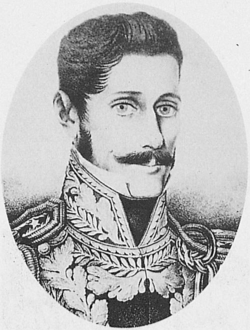You can help expand this article with text translated from the corresponding article in Spanish. (April 2013)Click [show] for important translation instructions.
|


The Cerrito Government (Spanish : Gobierno del Cerrito, lit. "Little Hill Government") governed almost all the Uruguayan territory during the Great Siege of Montevideo (1843-1851). It was led by Manuel Oribe y Viana. [1]
Contents
Uruguay was experiencing the Guerra Grande, between the two traditional parties Colorado and Blanco. Oribe sieged the city during 9 years; his headquarters were established on the Cerrito de la Victoria, at the present neighbourhood of Cerrito. Other notable posts were Villa Restauración (with tribunal and university) and Buceo (with its harbor).